Post-war use of captured German mortars
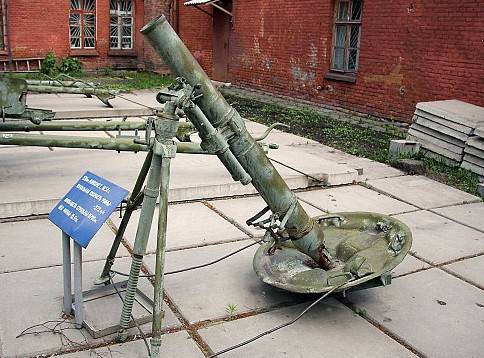
During World War II, the armed forces of Nazi Germany had a significant number of mortars of various calibers. After the surrender of the Third Reich, German-made mortars were in service in a number of states and were used in regional conflicts. German rocket-propelled mortars, which were fired using projectiles stabilized in flight by rotation, served as prototypes for Soviet, Chinese and Yugoslav MLRS in the post-war period.
50 mm mortar 5 cm leichte Granatwerfer 36
In 1934, the Rheinmetall-Borsig AG concern provided a 50-mm mortar for military testing, which was intended to be assigned to infantry companies. This mortar had a “solid” design, and all its elements were placed on a single carriage. The 460 mm long barrel and other mechanisms were mounted on a base plate. For guidance, a spindle adjustable in height and direction was used.
The mass of the mortar in firing position was 14 kg. Vertical aiming angles: from 42° to 90°. In the horizontal plane: 4°. Rough aiming was carried out by turning the base plate. The crew consisted of three people: a commander, a gunner and a loader. The crew could also be assigned ammunition carriers.
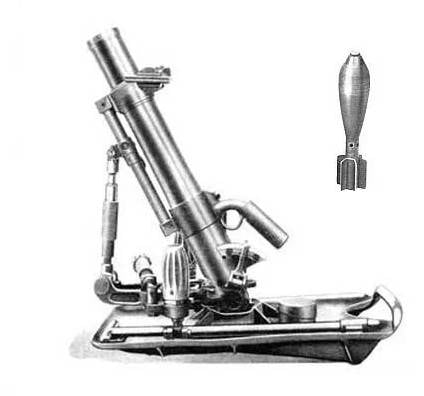
50 mm mortar 5 cm le.Gr.W. 36
The 50 mm company mortar entered service in 1936 under the designation 5 cm le.Gr.W. 36 (German 5 cm leichte Granatwerfer 36 - 5 cm light mortar of the 1936 model).
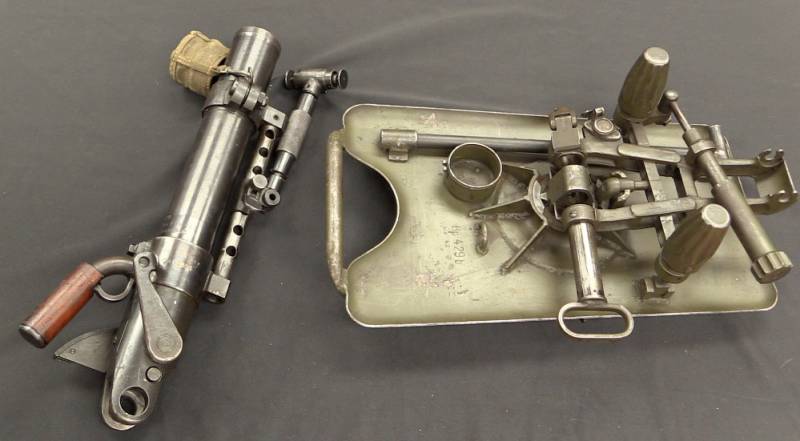
For transportation, the mortar was disassembled and carried in packs along with accessories and ammunition. The crew also carried first-stage ammunition - 5 boxes of 5 minutes each.
The firing was carried out with fragmentation mines weighing 0,91 kg, filled with 115 g of cast TNT. When a mine with a body made of cast iron exploded, the area affected by fragments reached 5 m.

50-mm mortar mine
Leaving the barrel at a speed of about 75 m/s, a 50-mm mine could fly to a distance of up to 575 m. The minimum firing range was 25 m. A well-trained crew was capable of firing 20 mines per minute. The combat rate of fire with aiming correction did not exceed 12 rounds/min.
As a means of fire reinforcement, each German infantry company according to the 1939 state was supposed to have three 50-mm mortars - one mortar per infantry platoon. The crew was part of the platoon control group. The infantry division was to have 84 50mm mortars.
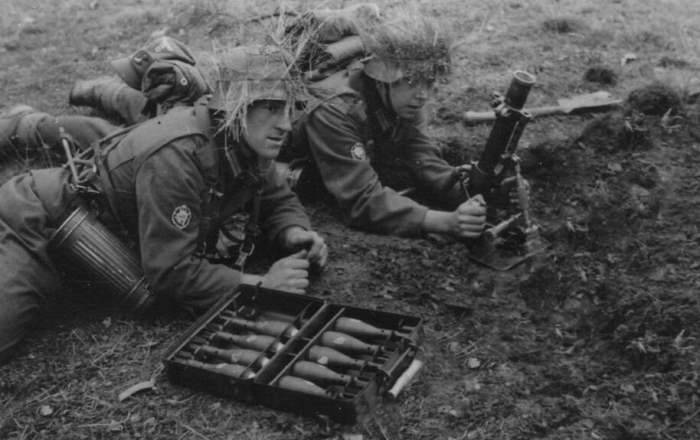
The Wehrmacht command had high hopes for 50-mm mortars, and this weapon up to a certain point it was produced in large volumes. As of September 1, 1939, the troops had about 6 company mortars. On April 000, 1, there were 1941 14 mm mortars and 913 rounds for them.
Despite their widespread use, 50-mm mortars were not popular among the troops, which was largely due to the inadequate level of reliability and safety of mortar mine fuses. There were often cases when mines did not explode when they hit soft soil, mud and a deep snowdrift. Or vice versa - detonation occurred immediately after the shot, which was fraught with the death of the crew. Due to the too high sensitivity of the fuse, shooting during rain or snowfall was prohibited.
In addition, the rather complex mortar had a short firing range; the crews were forced to get close to the enemy and often suffered losses from rifle and machine-gun fire. The fragmentation effect of the shells left much to be desired, and the high-explosive effect was not enough to destroy light field fortifications and wire barriers.
Due to low efficiency and unsatisfactory safety, in 1943 the production of 5 cm le.Gr.W mortars. 36 were rolled up. But the 50-mm mortars remaining in the troops were used until the end of hostilities.
The Red Army soldiers often captured German 50-mm mortars, but due to their low combat characteristics they used them limitedly against their former owners. Usually the enemy was shot at with the available ammunition, after which the 5 cm le.Gr.W. 36 were abandoned or handed over to a collection point for captured weapons.
Soviet partisans used captured company mortars to harass German strongholds in the occupied territory. Relatively light mortars were well suited for this. Having fired a dozen mines from the maximum distance, it was possible to quickly retreat.
At the end of 1944, specialists from the BTU GBTU, who analyzed combat experience, recommended more active use of captured 50-mm mortars in units of the armored forces of the Red Army participating in street battles to suppress enemy infantry holed up in attics and in shelters not accessible to a direct shot.
After the surrender of Nazi Germany, German-made 50-mm mortars, despite their shortcomings, were in service for some time in Romania, Bulgaria and Spain.
81 mm mortar 8 cm Granatwerfer 34
Battalion mortars 8 cm sGW 34 (German: 8-cm Granatwerfer 34) became widespread in the ground forces of Nazi Germany. The mortar, created in the early 1930s by Rheinmetall-Borsig AG, officially entered service in 1934.
Unlike the company 5 cm le.Gr.W. 36, this weapon was made according to the classic “imaginary triangle” design (Stokes-Brandt system) and consisted of a barrel with a breech, a base plate, a bipod and a sight.
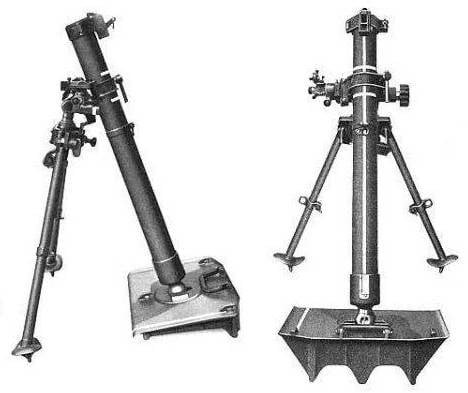
81 mm mortar 8 cm sGW 34
A biped-carriage consisting of two supporting legs identical in design (due to the presence of a hinged joint) allows for rough installation of vertical pointing angles. The exact installation was carried out using a lifting mechanism. Vertical aiming angles: from 45° to 87°. Horizontal aiming – 10°.
When ready to fire, the 8 cm sGW 34 weighed 62 kg. There is also a variant with a light alloy plate, the weight of which was 57 kg. When firing without aiming correction, the rate of fire reached 25 rounds/min.
A mine weighing 3,5 kg left a barrel 1 mm long with an initial speed of 143 m/s, which made it possible to hit targets at a range of up to 211 m. During World War II, an enhanced propellant charge with a firing range of up to 2 m was introduced. fragmentation, smoke and sighting mines could be included, which, when exploded, produced a flash and a smoke cloud clearly visible at a great distance.
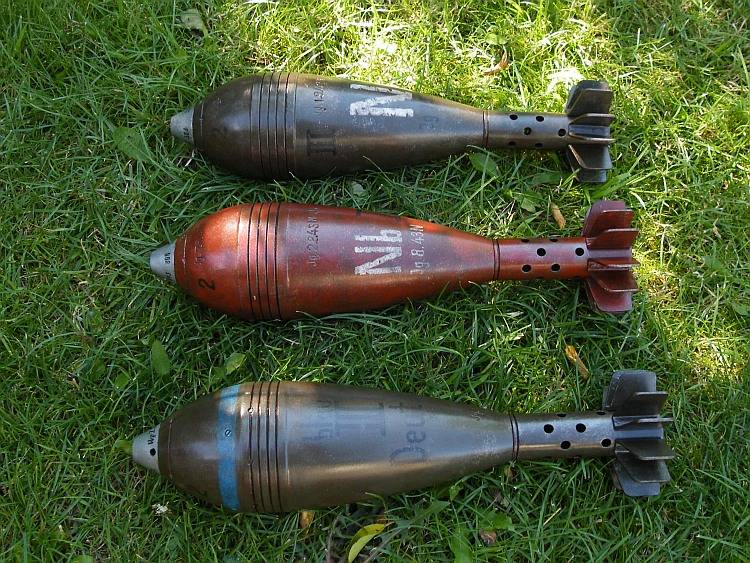
German 81 mm mines
81 mm fragmentation mines 8 cm Wgr. 34 and 8 cm Wgr. 38 contained from 480 to 530 g of cast TNT or ammatol. Fragmentation bouncing mine 8 cm Wgr. 39 was equipped with cast TNT and a powder charge in the head. The weight of the explosive is 390 g, the black powder is 16 g. The radius of destruction by fragments is up to 25 m.
In total, the German industry produced more than 70 000 cm sGW 8 mortars, which were used on all fronts. Each Wehrmacht infantry battalion was supposed to have six 34-mm mortars.
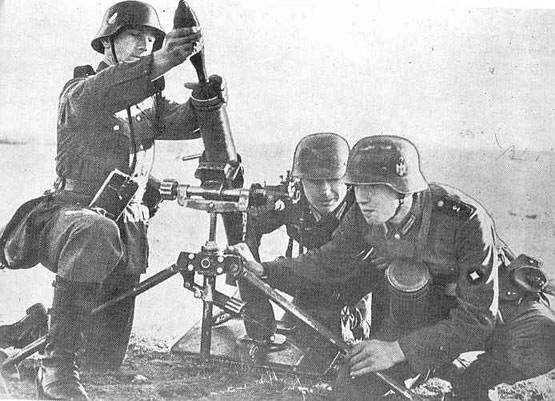
Also in 1942–1943. a shortened and lightweight 81-mm mortar Kurzer 8 cm Granatwerfer 42 (Kz. 8 cm Gr.W. 42) was produced.
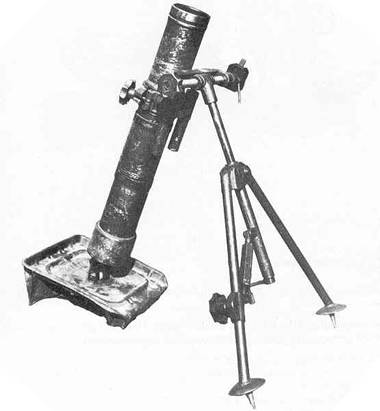
81 mm mortar Kz. 8 cm Gr.W. 42
Initially Kz. 8 cm Gr.W. 42 was intended for paratroopers, but they also tried to partially replace the not very successful 50-mm mortars in linear infantry units.
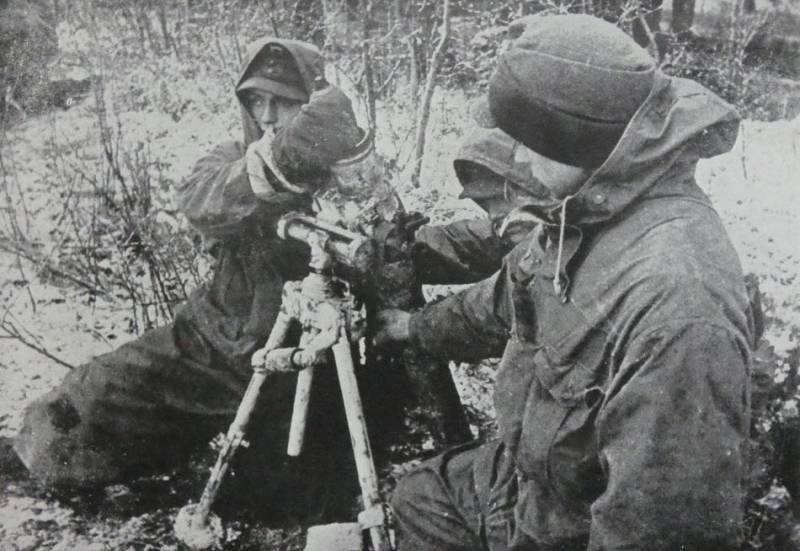
Mass Kz. 8 cm Gr.W. 42 in combat condition was 26,5 kg. With a barrel length of 747 mm, the maximum firing range reached 1 m. The rate of fire was up to 100 rounds/min. A total of 25 copies were produced.
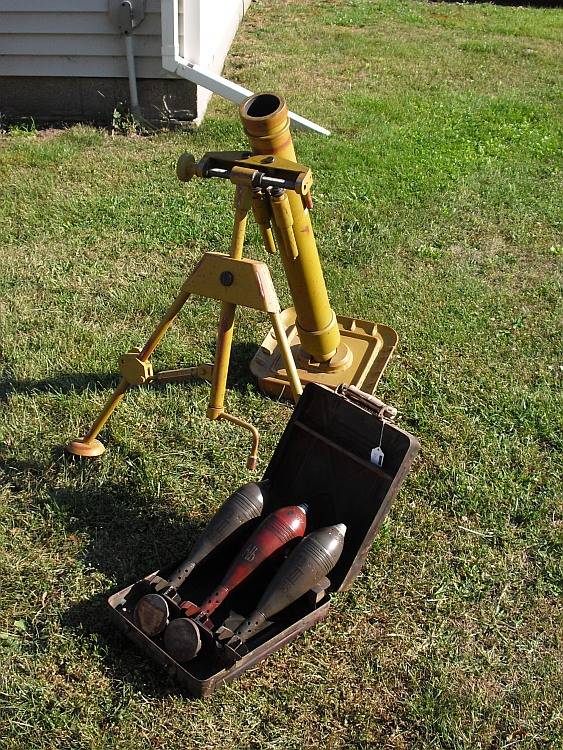
On September 1, 1939, the troops had 4 battalion mortars. As of June 624, 1, 1941 11-mm mortars were registered in the Wehrmacht infantry divisions. On January 767, 81, there were 1 1945 cm sGW 16 mortars in the active army.
The first German 81-mm mortars were captured by Soviet troops in the summer of 1941. In mid-1942, some infantry battalions of the Red Army received mortar batteries equipped with captured mortars.
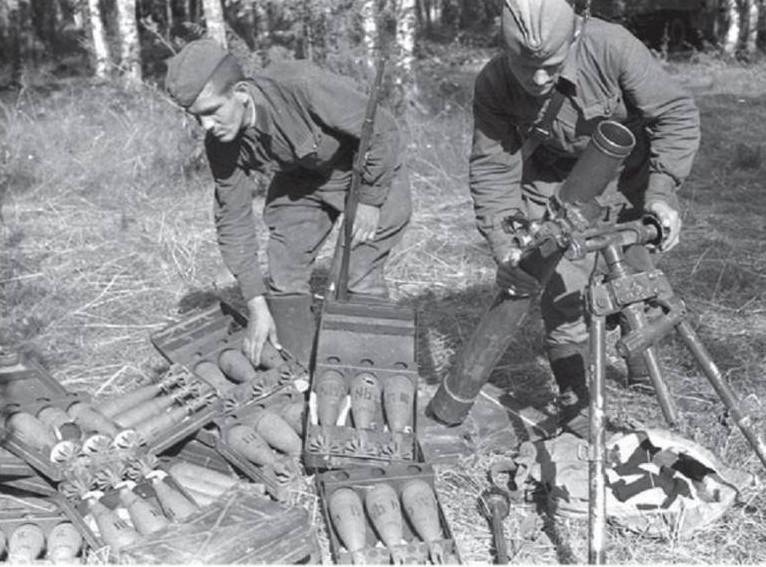
Operating instructions and instructions for the combat use of the 8 cm sGW 34, as well as firing tables, were published in Russian.
Throughout the war, soldiers of the Red Army actively used 81-mm mortars captured from the enemy, and after the surrender of Germany, a significant part of the mortars and rounds suitable for further use were sent for storage.
Several thousand 8 cm sGW 34 were in service in Albania, Bulgaria, Hungary, Czechoslovakia, Romania, Norway, Spain, Portugal, Yugoslavia, Finland and France in the post-war period.
81mm mortars supplied by Czechoslovakia subsequently surfaced in the Middle East and were used in the Arab-Israeli wars. Portuguese troops used German-made mortars against rebels in their African colonies in the 1960s and 1970s.
The armed forces of the Chinese Communists in the second half of the 1940s used 81-mm mortars, transferred by the Soviet Union, against Kuomintang troops.
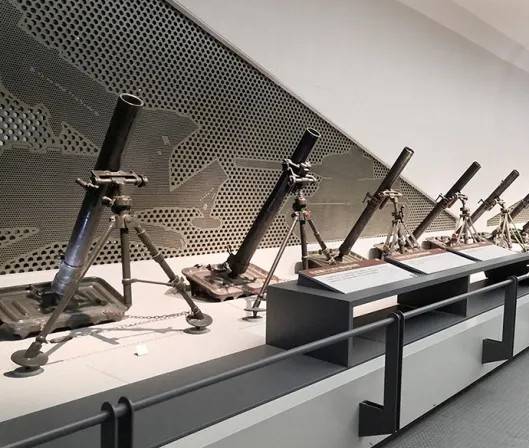
81mm mortars at the Military Museum of the Chinese Revolution
Subsequently, these mortars actively fought on the Korean Peninsula and fired at the French and Americans during the fighting in Southeast Asia.
In the 1960–1970s, the USSR supplied captured 81-mm 8 cm sGW 34 mortars to some national liberation movements and foreign armed groups, open support of which could have undesirable consequences.
120 mm mortar 12 cm Granatwerfer 42
At the time of the attack on the USSR, the armed forces of Nazi Germany did not have 120 mm mortars.
The 105 mm 10,5 cm Nebelwerfer 35 mortar, which was structurally an enlarged 81 mm 8 cm sGW34 mortar and was originally developed for firing chemical ammunition, did not perform very well. Fragmentation and high-explosive 105-mm mines weighing 7,26–7,35 kg were not powerful enough to reliably destroy wood-earth fortifications and make passages in wire fences.
In terms of firing range, the 105 mm mortar was slightly superior to the 8 cm sGW 34, but was almost twice as heavy. Already in 1941, due to unsatisfactory range and excessive weight, production of the 10,5 cm Nebelwerfer 35 mortar was discontinued.
At the same time, the German infantry was greatly impressed by the Soviet 120-mm mortar PM-38, which had a range of up to 5 m and was capable of firing 700 minutes per minute. Considering that a 15-mm mine weighing 120 kg contained up to 15,7 kg of TNT, its direct hit was enough to effectively destroy dugouts, bunkers and make passages in wire barriers.
In 1941, advancing German troops, who captured large numbers of PM-38s, used the captured ones under the designation 12 cm Granatwerfer 378 (r). And since January 1943, a German copy of the Soviet PM-38 under the name 12 cm Granatwerfer 42 (12 cm Gr.W. 42) was mass-produced at the Waffenwerke Brünn plant in Brno.
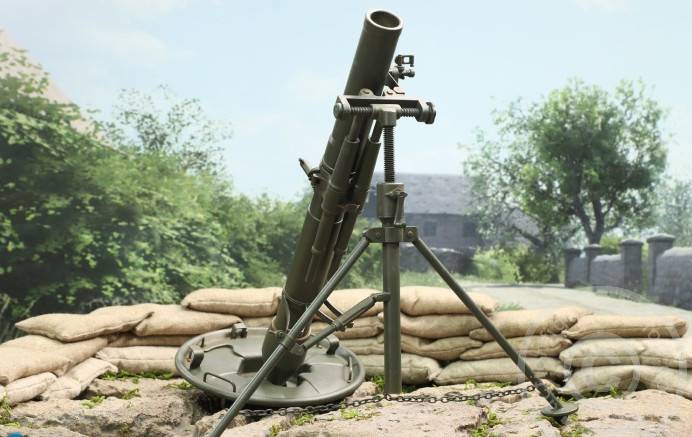
120 mm mortar 12 cm Gr.W. 42 in firing position
The German 120-mm mortar had a number of differences from the PM-38. First of all, this concerned parts associated with a different production technology, as well as sighting devices. The transport trolley has become stronger and has been adapted for towing with mechanical traction.
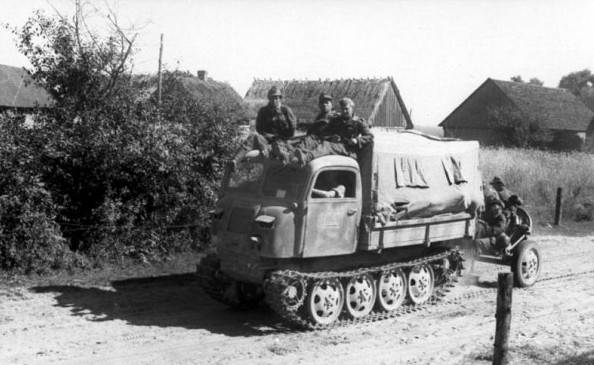
The mass of the mortar in combat position reached 280 kg. Thanks to the use of a more powerful propellant charge and a mine lighter by 100 g, the maximum firing range increased to 6 m. At the same time, the initial speed of the mine was 050 cm Wgr. 12 was 42 m/s, and the Soviet PM-283 was 38 m/s. At the same time, subject to amendments, it was possible to fire Soviet-made mines from a German mortar, and German 273-mm mines from a Soviet one.
From January 1943 to April 1945, 8 461-mm Gr.W mortars were fired. 120.
An interesting fact is that 120 mm mortars in the Red Army were routinely used at the regimental level, and the Wehrmacht command tried to replace 12 cm Gr.W mortars with mortars. 42 much more powerful, but also expensive 150 mm heavy infantry guns 15 cm sIG. 33, which were chronically in short supply after 1942.
At the final stage of the war, the Red Army captured several hundred 120-mm mortars produced in the Czech Republic. Taking into account the fact that for shooting from the German 12 cm Gr.W. 42 and the Soviet PM-38 could use the same mines, there were no difficulties with the supply of ammunition.
After the end of World War II, 12 cm Gr.W. mortars. 42 were in service in the same countries as the 81 mm. In the post-war period, the Czechoslovak company Zbrojovka Brno continued to produce 120-mm mortars, which were supplied to the Czechoslovak People's Army and sold to foreign customers. About a couple hundred 120 mm 12 cm Gr.W. Syria received 42 mortars; they were available in Cuba and the states of North Africa.
150 mm rocket mortar 15 cm Nb.W. 41
During the interwar period, many states developed means of delivering chemical weapons. In this regard, multiple launch rocket systems were very promising, which was reflected in the name of the first German serial 150-mm MLRS - “Fog Thrower” (Nebelwerfer) or “Smoke Mortar Type D”.
Subsequently, this installation, designated 15 cm Nebelwerfer 41 (15 cm Nb.W. 41), was used mainly for firing high-explosive fragmentation mines and only sometimes shells with a smoke-forming composition for setting camouflage smoke screens.
Testing of the 150mm six-barreled mortar and rocket mines began in 1937. And by the beginning of 1940, the MLRS 15 cm Nb.W. 41 and its ammunition was brought to the required level of reliability and perfection. This weapon was first used by the Germans during the French campaign.
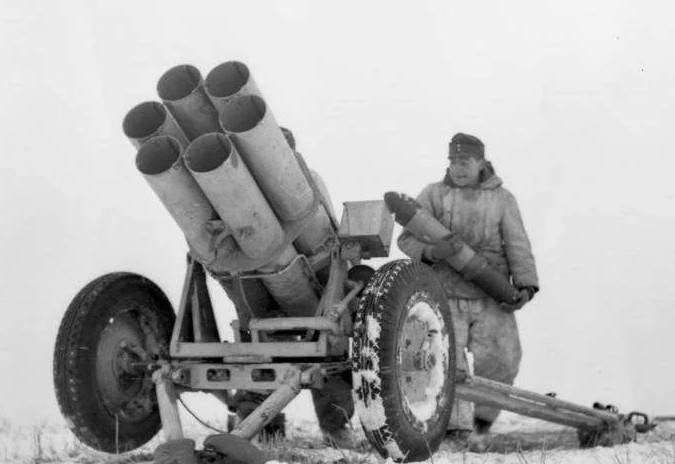
150 mm rocket launcher 15 cm Nb.W. 41 in firing position
The rocket launcher was a package of six tubular guides 1 mm long, combined into a block and mounted on a converted carriage of a 300-mm 37 cm Pak 3,7/35 anti-tank gun.
In the combat position, the wheels were hung out, the carriage rested on the bipod of the sliding frames and the folding front stop. Loading took place from the breech. Sometimes, for better stability when firing from launchers, the wheel drive was removed. There was a vertical guidance mechanism with a maximum elevation angle of 45° and a rotating mechanism that provided a horizontal firing sector of 24°.
The combat weight in the loaded position reached 770 kg, in the stowed position this figure was 515 kg. The installation could be rolled over short distances by crew forces. The volley lasted about 10 seconds. After pointing the mortar at the target, the crew went into cover and, using the launch unit, fired in series of 3 mines. When starting, the electric igniter is ignited remotely from the battery of the vehicle towing the unit. A well-coordinated crew of 5 people could reload a rocket launcher in 90 seconds.
If there was nothing outstanding in the design of the towed six-barrel mount, then the projectile for the 15 cm Nb.W. 41 had a revolutionary design for that time. Stabilization of the 15 cm Wurfgranete high-explosive fragmentation rocket mine on the trajectory was carried out by rotation at a speed of about 1 rpm, provided by inclined jet engine nozzles.
Unlike the Soviet M-8 and M-13 missiles, which are stabilized by fins, the stabilization efficiency is 15 cm Nb.W. 41 did not depend on the initial speed of the rocket, and turbojet shells had higher accuracy, since this method of stabilization also made it possible to compensate for the eccentricity of the engine thrust. In addition, shorter guides could be used.
At the same time, due to the fact that part of the energy of the escaping gases was spent on spinning the projectile, the firing range was less than that of a finned rocket.
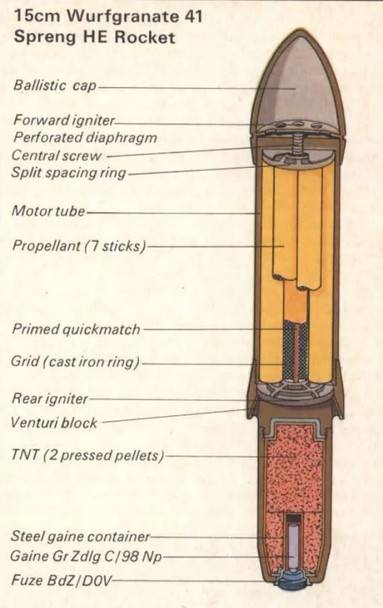
The explosive charge, consisting of 2 kg of TNT, was located in the tail section, and in the front section was a solid-fuel jet engine with a fairing, equipped with a perforated bottom with 28 nozzles inclined at an angle of 14°.
The maximum flight range of a high-explosive fragmentation rocket with a launch weight of 34,15 kg was 6 m. The maximum flight speed was 700 m/s. The scattering of lethal fragments during the explosion of a high-explosive fragmentation warhead was 340 meters along the front and 40 meters forward from the explosion site. Large fragments retained destructive power at a range of more than 15 m.
At a distance of 6 m, the dispersion of rockets along the front was 000–60 m, at range - 90–80 m. Higher firing accuracy than other multiple launch rocket systems made it possible to use German six-barreled mortars for firing not only area, but also targeted goals. Although, of course, with significantly worse efficiency than conventional 100-mm artillery guns.
At the beginning of 1942, the Wehrmacht had three regiments of rocket mortars (three divisions each), as well as nine separate divisions. The division consisted of three fire batteries, 6 installations in each. Since 1943, batteries of 150-mm rocket launchers began to be included in light battalions of artillery regiments of infantry divisions, replacing 105-mm field howitzers in them. As a rule, one division had two MLRS batteries, but in some cases their number was increased to three.
In total, the German industry produced 5 283 cm Nb.W rocket launchers. 15 and 41 million high-explosive fragmentation and smoke mines.
The enemy quite widely used six-barreled rocket mortars, and after Germany switched to strategic defense, they were often captured in good condition by our soldiers.
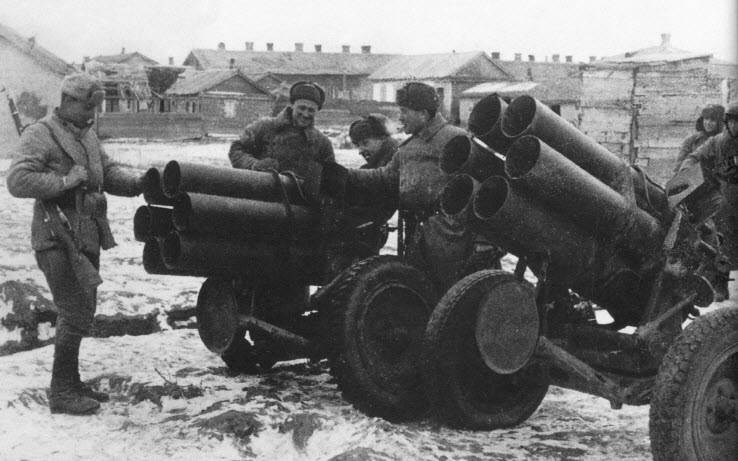
At the first stage, single installations captured from the enemy were supernumerary to Soviet units of regimental and divisional artillery. In 1943, the Red Army managed to form the first battery armed with German six-barreled mortars. To ensure the combat activities of artillery units armed with captured rocket launchers, the collection and centralized accounting of ammunition was organized. The shooting tables and operating instructions were translated into Russian.
We managed to find a report on the combat use of captured MLRS by units of the 347th division.
The report states that since November 1944, each of the three rifle regiments of the 347th Division had a “battery of six-barrel rocket-propelled mortars,” which were actively used as “roaming guns” for one salvo and then changing firing positions. It was noted that surprise attacks on German infantry units preparing for counterattacks were especially effective.
In addition to significant losses in manpower, the firing of the installations had a significant demoralizing effect on enemy personnel. In March 1945, the command of the 49th Army (2nd Belorussian Front) issued an order in which the artillery chiefs of corps and divisions were ordered to more actively use captured rocket launchers to destroy enemy defense points, anti-tank and barbed wire barriers.
Detailed information about the post-war operation of 15 cm Nb.W. 41 could not be found, but a number of sources claim that they were used by “Chinese people’s volunteers” during the fighting on the Korean Peninsula.
With American air supremacy aviation and hilly terrain, German six-barreled rocket mortars, which had good tactical mobility, performed better than the Soviet Katyushas. Towed installations could be rolled by crew forces and horse-drawn traction could be used.
In addition, the very compact German MLRS were much easier to camouflage than the Soviet BM-13N rocket artillery combat vehicles on a cargo chassis.
German rocket launchers, which used turbojets, had a significant influence on the development of rocket systems in the Soviet Union, China and Yugoslavia.
Thus, in the USSR in 1952, the BM-14 MLRS with a 140-mm TRS-140 turbojet was adopted. The installation was mounted on the chassis of all-wheel drive trucks ZIS-151, ZIL-157, GAZ-63, GAZ-66 and ZIL-131. In addition, the RPU-14 towed launcher with 16 guides was produced for the Airborne Forces.
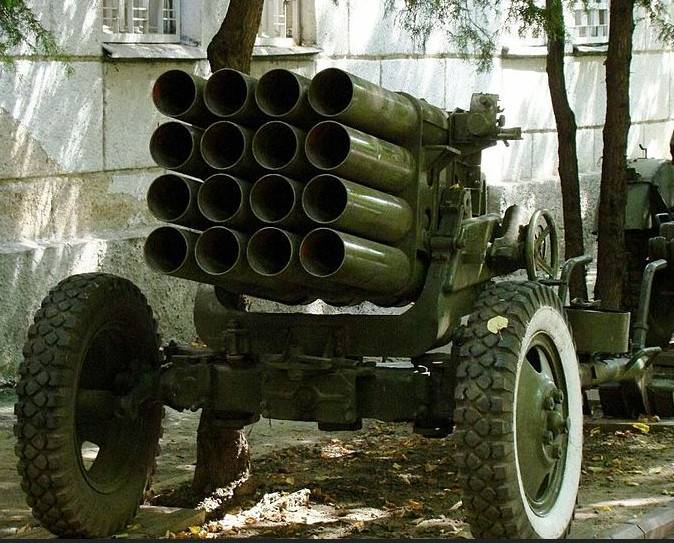
Towed launcher RPU-14
In Poland, an eight-round WP-140 installation was developed for TRS-8 missiles, which could be towed by a light all-wheel drive vehicle.
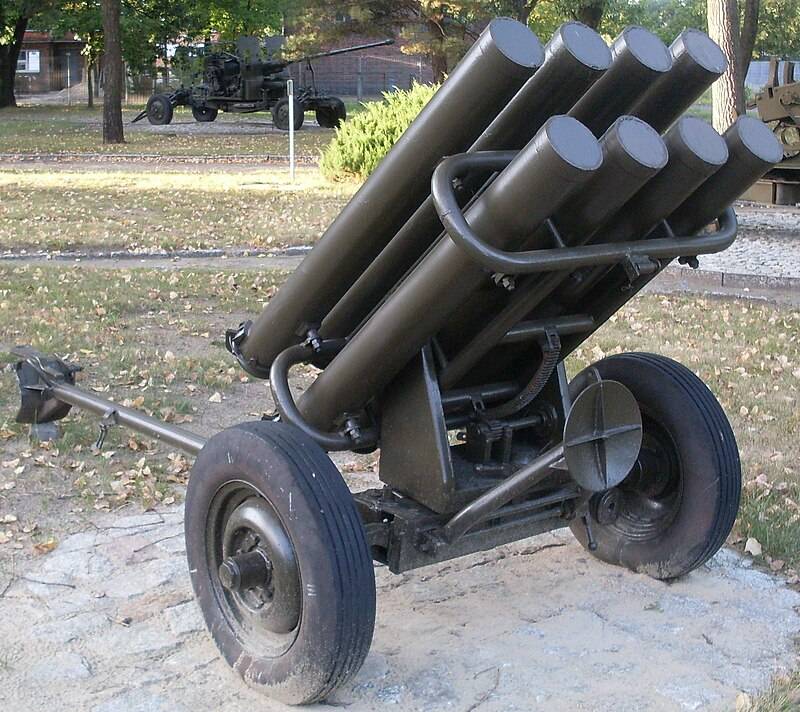
Towed launcher WP-8
In the mid-1960s, China began production of the Type 63 rocket launcher with 12 tubular guides of 107 mm caliber.
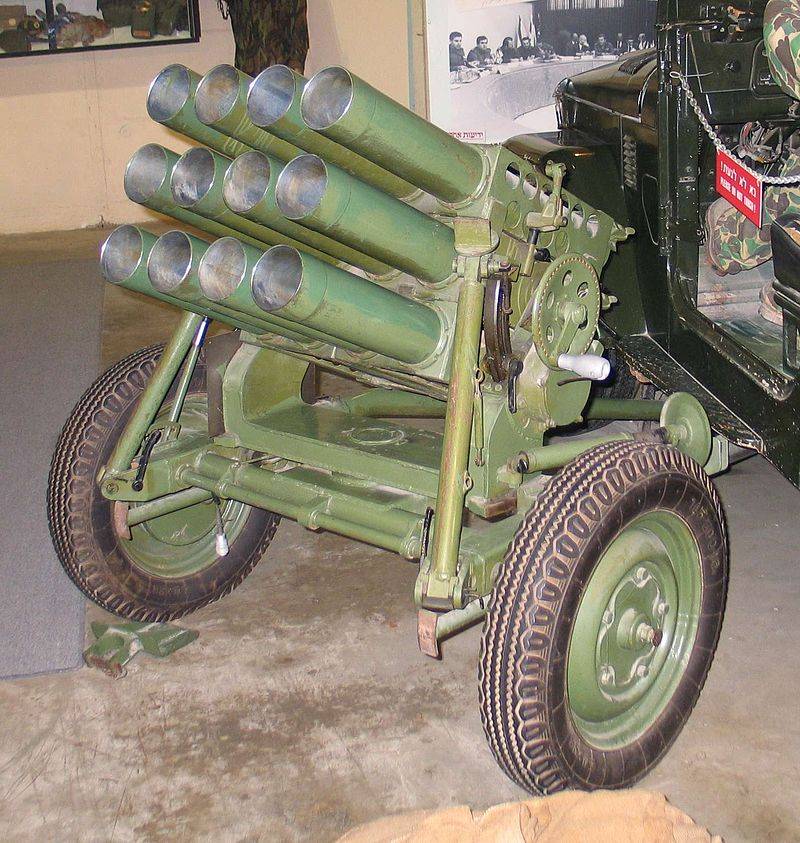
Type 63 towed launcher
This Chinese installation was produced in large quantities, is still used by the PLA and was actively exported.
Almost simultaneously with the PRC, Yugoslavia created and adopted the 128-mm M-63 Plamen MLRS, which in caliber and weight became intermediate between the Soviet RPU-14 and the Chinese Type 63.
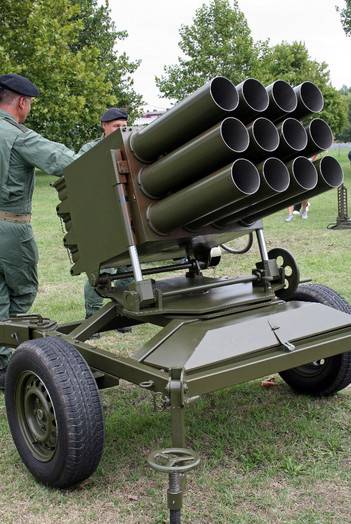
M-63 Plamen towed launcher
The first modification of the Yugoslav MLRS was towed and loaded with 12 shells. Later, a launcher with 32 tubular guides was created and entered service, which had towed and self-propelled versions.
Продолжение следует ...
Information